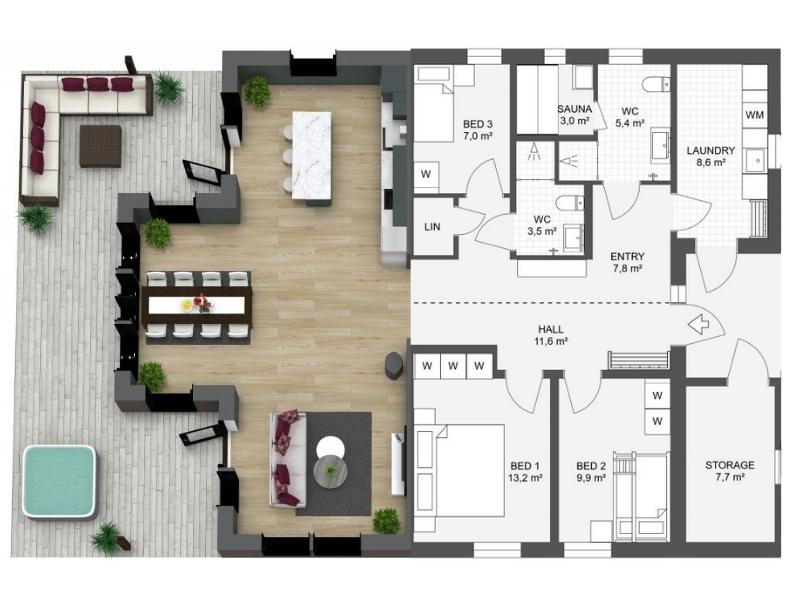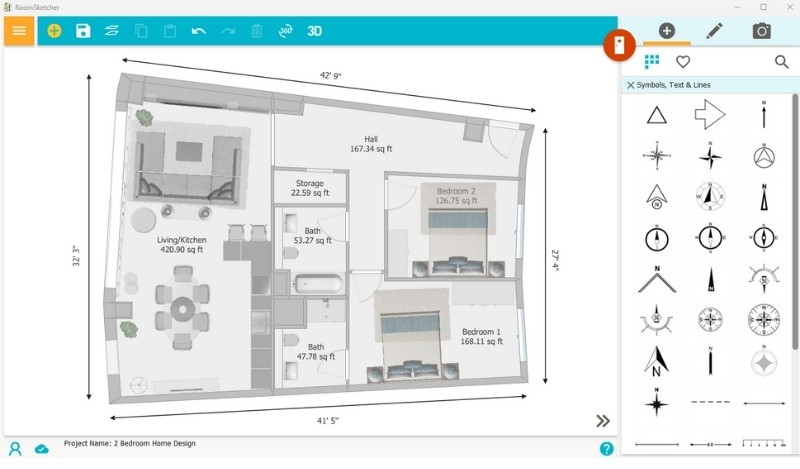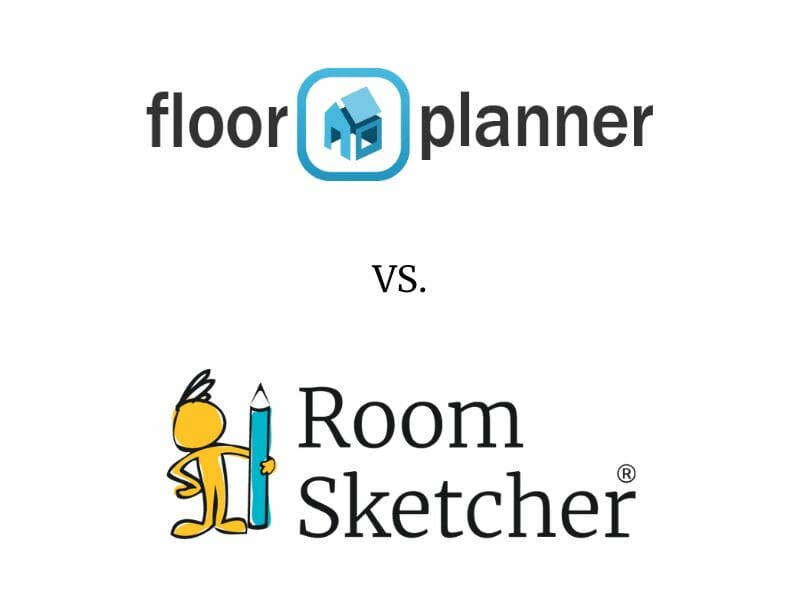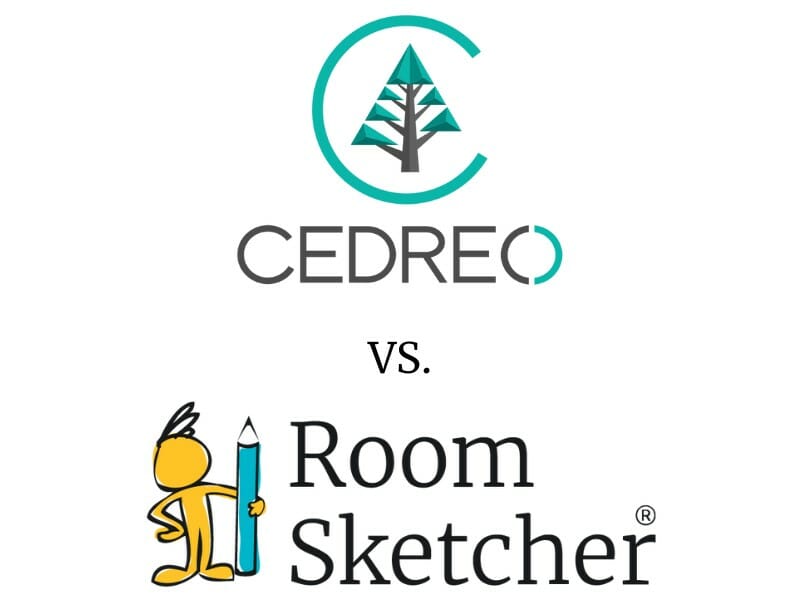The 8 Best Floor Plan Software Tools
Creating floor plans doesn’t have to be complicated. Check out the eight best floor plan software tools that help you make accurate layouts quickly.

Quick Summary:
RoomSketcher is the best overall floor plan software, combining an easy drag-and-drop interface with professional features like Live 3D walkthroughs, custom branding, redraw services, and cloud syncing.
Other tools have more limited use cases: Planner 5D is fun for casual DIY projects, Floorplanner is fine for quick basic layouts, and Cedreo or SketchUp suit specialized 3D modeling but lack ease of use. For simple 2D diagrams, PlanUp and Metropix are more restricted and best for UK real estate.
The market is flooded with floor plan software options, each promising to make your processes easier and more efficient.
The choices can be overwhelming, from professional tools to user-friendly apps for DIY enthusiasts.
That’s why we put the top software to the test, comparing their features, usability, and unique strengths, to help you cut through the noise and find the perfect fit for your needs.
What Is Floor Plan Software?
Floor plan software lets you draw, design, and visualize spaces in 2D and 3D. Before moving a single piece, you can map out rooms, test layouts, and even add furniture.
Whether you're selling a home or designing a building, these tools make it easier to bring your ideas to life.
Who Uses Floor Plan Software?
These tools aren't just for architects. Floor plan software helps:
- Interior designers and architects plan and present layouts
- Builders visualize and communicate construction plans
- Real estate agents showcase properties with floor plans and 3D walkthroughs
- Homeowners and DIYers plan renovations and rearrange furniture
- Event planners map out spaces for weddings, conferences, and more
- Business owners optimize retail and office layouts
The Best Floor Plan Software Tools
1. RoomSketcher

RoomSketcher stands out as a complete floor plan solution that’s powerful and easy to use. Whether you’re a builder, designer, real estate agent, or planning a home renovation, this software makes it easy to create detailed 2D and 3D plans.
What makes it different? RoomSketcher lets you customize floor plans with your own colors, materials, annotations, and even your company logo. Save your favorite styles to keep branding consistent across every project.
Live 3D walkthroughs bring your ideas to life instantly. Plus, with a constantly updated library of furniture and finishes, you’ll always have fresh options for any space.
You can work online or offline, and all your projects are stored in the cloud so they sync across your devices.
Standout features:
- Drag-and-drop editor for computer and tablet
- Interactive Live 3D
- Custom branding tools and saved styles
- Regularly updated furniture library and materials
- Work offline and sync projects across devices
- Redraw services to order floor plans
- Large library of learning resources
- Friendly and knowledgeable customer support team
- Easy sharing
- Flexible pay-as-you-go pricing
Join over 10 million people who already use RoomSketcher
2. Planner 5D

Planner 5D is a home design tool that lets users create 2D and 3D floor plans on desktop and tablet. It’s especially used by DIY home design enthusiasts for its wide furniture library and the ability to furnish spaces in both 2D and 3D modes.
Planner 5D’s 3D walkthrough feature is a highlight, allowing users to visualize their designs from any angle. However, customizing furniture materials and placing items can be cumbersome, and there’s no snapping feature to help align furniture precisely.
While Planner 5D offers basic measurement tools and 3D rendering, image quality may vary and can appear dark without added lighting.
Planner 5D is a solid choice for DIY enthusiasts who want flexible design tools and enjoy experimenting with layouts.
Pros:
- User-friendly design tools
- Furniture library with style and color options
- VR support
Cons:
- No snapping for furniture alignment
- Image quality can vary without lighting adjustments
Read our full Planner 5D review.
3. Floorplanner

Floorplanner is a web-based tool known for quick, basic 2D and 3D layouts.
Users can quickly draw layouts and add furniture from a large built-in library, making it a common choice for home design enthusiasts and real estate agents who need fast results.
While Floorplanner excels at easy drag-and-drop design and instant 3D visualization, its customization options are somewhat limited. Advanced editing features and high-resolution exports are only available in higher-tier plans, and some users may find the interface less flexible for complex projects.
Floorplanner does not offer redraw services, and its support is mainly through online resources rather than direct customer service.
Floorplanner is suitable for creating simple floor plans and 3D views without a steep learning curve. However, it lacks detailed customization and advanced features for professionals.
Pros:
- Instant 2D and 3D views
- Large object library
- Easy to use
Cons:
- Limited customization
- No redraw services
Read our full Floorplanner review.
4. Cedreo

Cedreo is a browser-based floor plan software designed for professionals who need detailed 3D home and interior designs.
It offers a robust furniture library and the ability to create both 2D and 3D floor plans.
However, Cedreo’s interface can feel complex and less intuitive, especially for new users. Navigating the software and customizing items sometimes requires extra steps, and certain features, like furniture placement and color adjustments, can be less flexible than expected.
Cedreo’s 3D mode provides realistic walkthroughs and quality renders, but there are limitations in customizing furniture sizes and materials.
The software is only accessible on desktop browsers and does not support tablets or offline work.
Pros:
- Create and edit 2D and 3D layouts
- Good for builders and architects
Cons:
- Steep learning curve
- Only available on desktop
- Limited furniture customization
Read our full Cedreo review.
5. SketchUp

SketchUp is a 3D modeling tool widely used for architectural design and visualization.
Unlike dedicated floor plan software, SketchUp offers a flexible platform for creating detailed models, but this versatility comes with a steeper learning curve. Users must manually draw and assemble floor plans line by line, which can be time-consuming compared to more specialized solutions.
Adding furniture and customizing materials in SketchUp often requires extra steps and sometimes third-party plugins, making the process less intuitive for beginners.
While SketchUp excels in general 3D modeling and offers a vast library of objects, its basic floor plan visuals are less realistic without additional plugins.
SketchUp remains a solid choice for users who need advanced 3D modeling capabilities and are comfortable with a more complex workflow. However, those seeking fast, user-friendly floor plan creation may find more value from other tools.
Pros:
- Ideal for complex 3D projects
- Extensive object library
Cons:
- Manual drawing required
- Beginners may find it overwhelming
Read our full SketchUp review.
6. SmartDraw

SmartDraw is mainly a diagramming tool with basic 2D floor plan templates.
The software works only online and on computers, which can be limiting for users who prefer tablets or need offline access.
While SmartDraw offers a solid range of 2D symbols and measurement tools, it lacks 3D floor plan features and advanced visualization options.
Customizing furniture and materials is possible, but the process isn’t as intuitive as with more specialized floor plan software. SmartDraw does not offer redraw services or high-quality 3D renders, making it less ideal for real estate or interior design professionals who want immersive visuals.
However, its customer support is responsive, and it offers flexible subscription plans.
It's a practical choice if you need a straightforward tool for simple 2D plans and already use SmartDraw for other diagrams.
Pros:
- Works well for business diagrams
- Responsive support
Cons:
- No 3D features
- Only works online
Read our full SmartDraw review.
7. PlanUp

PlanUp is built for UK real estate agents and energy assessors. It offers basic tools for drawing floor plans on desktop and tablet, using a straightforward room-by-room method for simple layouts.
The software provides limited customization, with a small selection of bathroom and kitchen fixtures and only basic options for color changes. PlanUp’s 3D floor plans are simple, with fixed viewing angles and minimal flooring choices.
PlanUp is a practical choice for professionals who need quick, uncomplicated floor plans for property listings and domestic energy survey reports, especially in the UK market.
Pros:
- Simple room-by-room editor
- Quick 2D and basic 3D visuals
Cons:
- Minimal customization
- Basic furniture and fixture options
Read our full PlanUp review.
8. Metropix

Metropix offers simple 2D plans for UK real estate
It allows users to draw simple 2D floor plans on a computer or tablet, but it lacks cloud-based storage, so projects can’t be accessed or edited across multiple devices.
Metropix offers a limited library of 2D symbols and furniture, with minimal customization options. You can add preset colors to rooms, but can’t choose or change them yourself.
While Metropix does provide 3D floor plans, they are non-editable and offer minimal customization or furniture selection. The redraw service is slower and less flexible than competitors, requiring a paid subscription and several days to process.
Pros:
- Fast for simple layouts
Cons:
- No cloud storage
- Limited editing and customization
Read our full Metropix review.
Get Started with RoomSketcher Today
After testing the top options, RoomSketcher stands out as the #1 floor plan software overall. It’s the only solution that balances ease of use with pro-level features like Live 3D walkthroughs, custom branding, redraw services, and cloud syncing.
But don't just take our word for it. Create an account today and explore the features for yourself!
Frequently Asked Questions (FAQ):
Look for 2D and 3D design options, furniture libraries, drag-and-drop functionality, and tools like Live 3D walkthroughs. RoomSketcher includes all of these and more.
Not always. RoomSketcher lets you work offline, and your projects sync when you're back online.
Yes. RoomSketcher, Planner 5D, and Floorplanner all have tablet-friendly versions so you can design on the go.
RoomSketcher is a top-rated floor plan software for Mac users. The app runs smoothly on macOS and lets you create, edit, and visualize floor plans in 2D and 3D.
RoomSketcher is the best all-around choice if you want 3D floor plans that look professional and are easy to create. You can draw your layout, add furniture, change colors and materials, and then see the whole space in realistic 3D. You can also walk through your design in Live 3D, making it easier to understand how everything fits together.
RoomSketcher, Cedreo, and Planner5D provide high-quality 3D visualization to help bring your designs to life.
RoomSketcher is a top choice for real estate professionals, along with PlanUp and Metropix for quick, simple plans.
What Can You Use Floor Plan Software For?
Floor plan tools aren’t just for drawing walls. They can also help you plan, present, and visualize real spaces. Here are a few smart ways people are using them:
Real Estate Marketing
Agents often use floor plan software to stand out online. By adding a clean floor plan and 3D view, buyers can visualize how the home flows and imagine themselves living there. It improves engagement and speeds up decision-making.
Real estate photographers can also add value by including floor plans alongside high-quality photos
Interior Design
A designer needs to show multiple layout options to a client during a pitch. With floor plan software, they can present ideas clearly and adapt the design in real time based on feedback.
Home Builders
Instead of relying on blueprints, home builders can use floor plan software to walk through the space together and catch any needed changes early.
Property Management:
From rental listings to remodels, property managers use floor plans to plan out upgrades, show unit layouts to potential tenants, and keep a record of what’s inside each space.
Event Planning
Whether it's a wedding reception or a business expo, planners use floor plan software to design the flow of the event. You can plan everything from entrance placement to booth layouts and seating arrangements.
Property Appraisals
For appraisers, floor plan software offers a fast way to create accurate layouts that support property valuation. Visualizing square footage, layout flow, and structural changes can improve your reports and provide more detailed documentation for clients.
Home Renovation
Have you ever tried to rearrange your living room, but you're not sure what fits where? With floor plan software, you can test layouts, preview new colors or furniture styles, and see the impact in both 2D and 3D before picking up a single tool. It's a big help when it comes to avoiding costly changes.
Join over 10 million people who already use RoomSketcher
See How RoomSketcher Compares

Planner 5D vs. RoomSketcher
Planner 5D vs. RoomSketcher - which floor plan software is right for you? Check out our deep-dive comparison now.

Floorplanner vs. RoomSketcher - Which Tool is Right for You?
Read our thorough Floorplanner vs RoomSketcher Comparison - Find out which floor plan solution is best for you.

Cedreo vs. RoomSketcher
Cedreo vs. RoomSketcher - which floor plan software is right for you? Check out our deep-dive comparison now.
